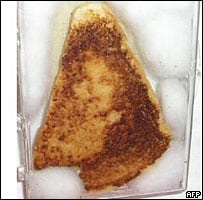Pareidolia is a fascinating psychological phenomenon that occurs when the brain interprets vague stimuli as something significant, often recognizing familiar patterns, such as faces, in random images or objects. This remarkable ability to find meaning in chaos is a testament to our brain’s propensity for pattern recognition and interpretation.
What Is Pareidolia?
Many people experience pareidolia without realizing it. Common examples include spotting animals in cloud formations or seeing the likeness of a religious figure in the burnt surface of toast. Scientists are continually exploring this phenomenon to understand its underlying mechanisms.

Why Does Pareidolia Happen?
Numerous theories attempt to explain why pareidolia occurs, with one central idea being that the brain instinctively seeks to make sense of what it observes. It actively looks for patterns and assigns meaning wherever possible. A specific region of the brain, particularly in the temporal lobe, is responsible for facial recognition. This skill is crucial not only for identifying friends but also for recognizing potential threats, which had significant survival value throughout human evolution.
Another contributing factor is confirmation bias. When a person is actively trying to find shapes resembling faces—like searching for cloud shapes—they are more likely to notice them, reinforcing their expectations. Similarly, a person might only recognize a face in their toast after someone else points it out.
Motion Pareidolia: A Unique Perspective

Another intriguing variant of this phenomenon is motion pareidolia, also known as kinetic pareidolia. This occurs when individuals perceive illusory movement in static images or in peripheral vision. For example, you might see patterns that seem to shift or change shape when you’re sleep-deprived or in low light conditions. In these instances, your brain is filling in visual gaps, creating the illusion of movement where none exists.
The Brain’s Preference for Faces
Kang Lee, a professor of applied psychology and human development at the University of Toronto, has conducted extensive research on how individuals process faces across different ages. His findings indicate that the brain often absorbs and interprets information about faces before we consciously recognize them.
Lee explains, “The inferior frontal gyrus is a crucial area for generating ideas and instructing the visual cortex to recognize them. If the idea is a face, the brain will perceive it accordingly—be it the face of Jesus, Elvis, or any person of significance.” This suggests our brains are wired to recognize familiar patterns, especially faces, almost subconsciously.
Assigning Emotion to Inanimate Objects
Beyond recognizing faces, humans also instinctively assign emotions and personalities to inanimate objects. This is exemplified by the use of emoticons (like 🙂 and 🙁), where simple characters convey complex feelings. It demonstrates how our brain interprets and relates to shapes and forms, often ascribing emotional significance.

Iconic Examples of Pareidolia
One of the most renowned examples of pareidolia is the “man in the moon.” Many cultures have created legends about this phenomenon, with observers often able to see a face in the moon’s surface. According to planetary scientist Ya Huei Huang from MIT, the moon’s craters and lava basins create the illusion of facial features, drawing on contrasts that make the “face” easily recognizable.
Another famous instance is the Virgin Mary on a grilled cheese sandwich. In the 1990s, Diane Duyser made a sandwich that appeared to contain the image of the Virgin Mary. She preserved it, and over ten years later, the sandwich was sold on eBay for an astonishing $28,000, attracting significant media attention. Such stories highlight how pareidolia can elevate simple objects into cultural phenomena, often associated with religious significance.
The Power of Perspective
Lee notes that inducing pareidolia is relatively simple. In one of his studies, participants reported seeing faces about 34% of the time even in gray static images, indicating that our brains are always on the lookout for recognizable patterns.
To explore this phenomenon actively, challenge your creativity by looking for faces in your home or neighborhood. You might be surprised by how many faces your mind conjures up from everyday objects.